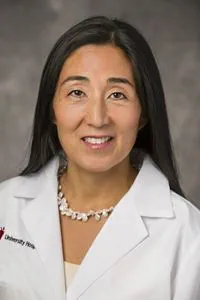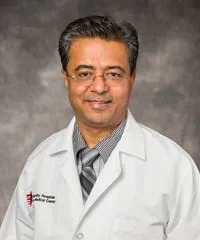Stem Cell Transplantation Program at UH Rainbow Uniquely Positioned to Offer Optimal Care
November 01, 2017

UH Innovations in Pediatrics - Fall 2017
 Mari Dallas, MD
Mari Dallas, MD Jignesh D. Dalal, MD
Jignesh D. Dalal, MDStem cell transplantation has become mainstay of treatment in certain childhood cancers, including certain leukemias and lymphomas. However, in centers with more clinical experience with the procedure, children and teens with more rare non-malignant diseases can also benefit.
“Not a lot of centers will do the rare diseases, just because of experience,” says Mari Dallas, MD, Pediatric Hematologist and Oncologist, Angie Fowler Adolescent & Young Adult Cancer Institute, University Hospitals Rainbow Babies & Children’s Hospital and Associate Professor of Pediatrics, Case Western Reserve University School of Medicine. “Here at UH Rainbow, we do see more rare diseases, such as hemoglobinopathies, metabolic diseases and immunological deficiencies, among others. We can provide a stem cell transplant to almost any patient using different donor sources. This includes matched siblings, matched unrelated, haploidentical family members, as well as umbilical cord blood.”
Certain patients can also benefit from the innovative combination of haploidentical stem cells and cord blood, Dr. Dallas says.
“Cord blood volume is small, so it’s hard to get them into bigger kids or into kids with a strong immune system that doesn’t want to take it,” she says. “With haploidentical cells, you can get a lot of cells and they go in very quickly, but it’s not a perfect match. If you can get the big haploidentical cells to get the baby cord cells in, then the cord cells can take over while the haploidentical cells go away. It bridges the wonderful pros and cons of both.”
“This approach does help to facilitate engraftment,” adds Jignesh Dalal, MD, Director of Pediatric Bone Marrow Transplantation, Angie Fowler Adolescent & Young Adult Cancer Institute, UH Rainbow Babies & Children’s Hospital; Professor of Pediatrics, Case Western Reserve University School of Medicine.
In addition to broadening donor options for patients, the stem cell transplant team at UH Rainbow also takes scrupulous care to determine the optimal candidates and timing for the procedure.
“Sometimes it is very hard in a condition to determine whether a transplant will be or will not be helpful,” Dr. Dalal says. “That expertise is sometimes needed. We must consider not only how to do the transplant, but when to do the transplant and whether we should do the transplant. All of those questions are getting tougher and tougher to answer, but that expertise is available here.”
For example, a genetic test may show that a patient has an inherited disease, but the child may not yet have a full manifestation of the disease.
“The question becomes whether to do the transplant at six months or five years or 15 years,” Dr. Dalal says. “It’s a matter of clinical judgment.”
Another key advantage both Dr. Dallas and Dr. Dalal see for their stem cell transplant patients at UH Rainbow is the proximity of UH’s flagship academic medical center – UH Cleveland Medical Center – and a freestanding cancer hospital – UH Seidman Cancer Center – all on one self-contained campus.
“Other children’s hospitals cannot afford to do what we can afford to do,” Dr. Dalal says. “When a patient is in critical condition, it is very difficult to transfer. It is a very practical issue but very important.”
The collaboration between the facilities also means that patients receive treatment from the team best-suited for their condition – irrespective of their age.
“We work very closely with our adult oncology colleagues, not just in the transfer of care after treatment, but also in the intake period where we evaluate a patient and determine whether they should be best seen in the adolescent or the adult world,” Dr. Dallas says. “It’s not always pediatrics. If you have a young patient with a very adult-like treatment plan, they benefit from being treated by our adult colleagues.”
For adolescent stem cell patients, Angie’s Institute also offers a welcoming social environment and important services such as a fertility preservation. One other important factor: All stem cell transplant patients at UH Rainbow are enrolled into a formalized clinic for long-term follow-up.
“Post-transplant, long-term follow- up is one of the key components of good survival,” Dr. Dallas says. “We ask a lot from these young patients and we owe it to them to ensure a healthy future.”
For more information about the stem cell transplantation program at UH Rainbow Babies & Children’s Hospital or to refer a patient, please email Peds.Innovations@UHhospitals.org.


